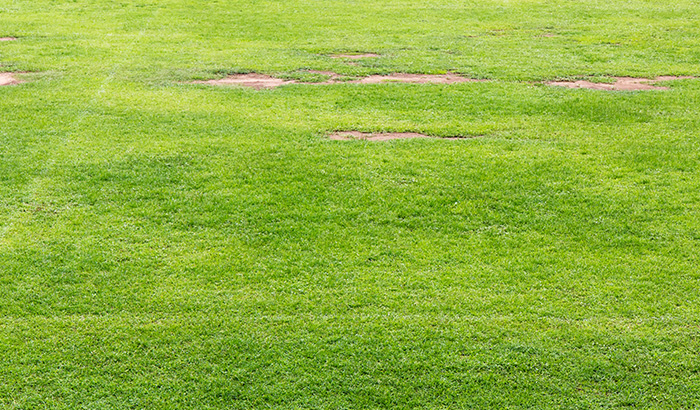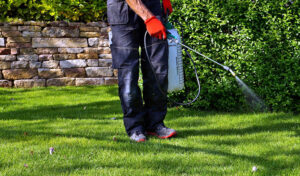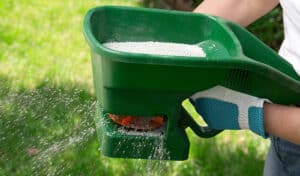Your healthy lawn is more than a beautiful backdrop; it reflects your commitment to outdoor beauty and property value. Maintaining its splendor requires vigilance, as lurking diseases can compromise its vitality.
Your lawn is an evolving ecosystem where grass, soil, weather, and care practices intertwine. Similar to diagnosing ailments, you can spot disease signs like discoloration, texture changes, and irregular growth. Early recognition saves you from advanced damage. This blog equips you with a toolkit to assess your lawn’s health, spot subtle hints, and take proactive measures.
Discover key disease indicators and how to combat them. From patchy discolorations to abnormal growth, each sign reveals your lawn’s health. Armed with this knowledge, you’ll differentiate wear and tear from potential threats, ensuring a flourishing lawn.
1. Patchy or Discolored Areas: Deciphering the Language of Your Lawn
A healthy lawn presents itself with a uniform and vibrant carpet of grass. Each blade contributes to an overall tapestry of color and texture that’s pleasing to the eye. However, when diseases make their presence felt, this harmony can be disrupted, leading to the emergence of patchy or discolored areas.
These patches can appear as spots of brown, yellow, or even grayish discoloration amidst the lush greenery. What was once a seamless expanse now bears the marks of underlying health issues. These discolorations signal that your grass is facing stress and that some parts are struggling more than others.
Lawn diseases often take advantage of weakened areas in the grass, whether due to poor drainage, inadequate sunlight, or other factors. These areas become susceptible, and diseases move in, leading to the uneven and discolored appearance you’re observing. The brown, yellow, or gray patches are indicative of the damage occurring beneath the surface.
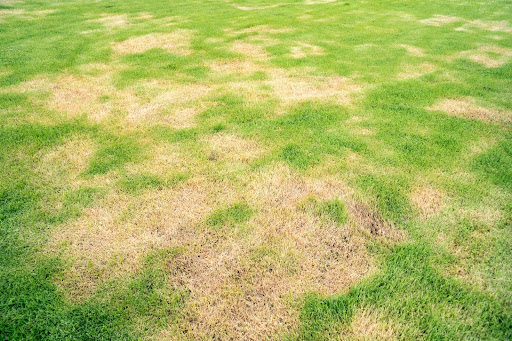
2. Irregular Growth Patterns: Decoding Lawn Health Through Growth
A well-kept lawn boasts a consistent and balanced growth pattern. However, when diseases come into play, the familiar rhythm can be disrupted, leading to uneven growth that tells a tale of underlying health issues.
Diseases can trigger irregular growth patterns, causing some areas of your lawn to grow taller and more vigorously than others. This inconsistency stands out like a sore thumb against the backdrop of your carefully tended lawn. Instead of the lush, uniform carpet you’re used to, you might notice sections that seem to be racing ahead in their growth while others appear lagging.
On the flip side, stunted growth is another sign that your lawn might face disease-related challenges. If certain areas are struggling to keep pace with the rest, it could be due to underlying disease issues hindering their growth potential. These struggling areas often appear weaker, thinner, and less vibrant than their counterparts.
The irregular growth patterns your lawn displays can be more than just a quirk; they can be direct indicators of fungal or bacterial infections. Diseases like these target specific sections of your lawn, affecting their ability to grow at a healthy rate. As a result, the areas experiencing rapid growth might be battling fungal infections, while the stunted areas could be grappling with bacterial invaders.
3. Abnormal Texture: Understanding Lawn Diseases Through Touch
When it comes to your lawn, appearance isn’t the only thing to keep an eye on. The texture of your grass can reveal a lot about its health. Diseases often wield their influence through changes in texture, offering you yet another clue to decoding the story your lawn is telling.
Lawn diseases can have a significant impact on the way your grass feels underfoot. What was once a lush and velvety surface might now exhibit unusual changes in texture. These variations can range from the grass feeling overly soft and slimy to becoming coarser and less pleasant to touch.
One notable example is the slimy or greasy appearance that fungal infections can induce on the grass blades. This slimy film isn’t just an aesthetic concern; it’s a tangible sign that your lawn is contending with a fungal intruder. Fungal diseases create the perfect environment for this change, altering the natural texture of the grass.
By running your hands over your lawn and feeling for these textural changes, you can unveil valuable insights about potential diseases. These changes aren’t just random occurrences — they’re specific reactions to the presence of certain pathogens. Armed with this knowledge, you can accurately identify the type of disease at play and take targeted measures to tackle it.
Texture changes provide a unique diagnostic tool in your arsenal. You can paint a more comprehensive picture of your lawn’s health when combined with other signs like discoloration and growth patterns. This information empowers you to make informed decisions, from adjusting your lawn care routine to selecting the most appropriate treatments.
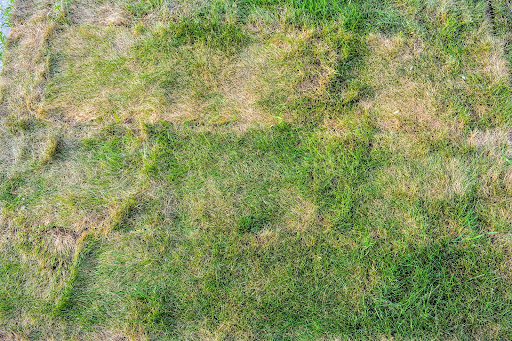
4. Presence of Patches or Rings: Deciphering Circular Lawn Clues
Imagine a symmetrical pattern of patches or rings gracing your lawn like intricate artwork. While this might sound enchanting, these formations can clearly indicate underlying diseases. Understanding how certain diseases manifest as these circular patches or rings can give you further insight into your lawn’s health.
Lawn diseases like fairy rings or necrotic ringspots are masters of creating distinct circular patterns. These formations often start as subtle discolorations — an area that looks slightly different from the rest. However, these initial discolored patches are just the beginning.
Over time, these discolored areas evolve, forming more evident circular patches or rings. The progression might not be swift, but it’s steady. These rings or patches can range from a few inches to several feet in diameter. They stand out due to the stark contrast they create against the surrounding healthy grass.
Fairy rings, for instance, are caused by fungi that reside in the soil and break down organic matter. This leads to the development of the characteristic dark green or brown rings, with the grass inside the ring often becoming lush and vibrant. On the other hand, necrotic ringspot is a disease where the grass within the ring dies off, leaving a noticeable void.
The circular pattern isn’t just a coincidence. It’s a consequence of how these diseases spread underground. As the pathogens grow outward from a central point, they manifest as these rings or patches. This unique presentation sets them apart from other issues affecting your lawn.
5. Increased Weed Infestation: The Link Between Lawn Health and Weeds
A well-maintained lawn isn’t just about cultivating a lush carpet of green. It’s also about creating an environment where your grass thrives while unwelcome guests like weeds are kept at bay.
However, diseased lawns can disrupt this balance, inviting weeds to take center stage. Understanding the connection between lawn health and weed infestation is crucial to maintaining a vibrant and weed-free landscape.
Diseases weaken your lawn’s natural defenses, leaving it more susceptible to various threats, including weeds. When the grass struggles to fight disease, it becomes less capable of competing with invasive plants. This weakened state allows weeds to establish themselves and flourish as they seize the chance to occupy the gaps left by the struggling grass.
Weeds are opportunists. They seize any chance to grow and multiply. A lawn suffering from disease provides the perfect breeding ground for weeds. With compromised grass struggling to maintain its territory, weeds find an ideal opening to germinate, grow, and spread their roots. Once established, they can quickly overtake weakened areas, further exacerbating the health issues of your lawn.
A strong, healthy lawn acts as a natural deterrent to weed growth. Dense and thriving grass leaves little room for weeds to take root. On the other hand, a diseased and weakened lawn creates an environment where weeds can flourish unhindered. The more extensive the disease damage, the more space and resources weeds have to claim.
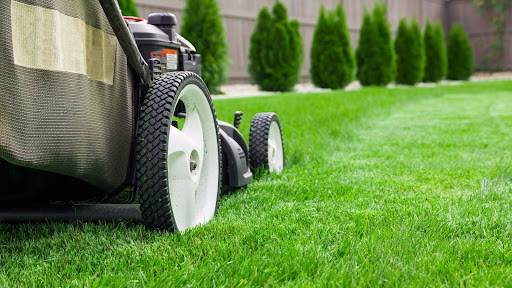
Addressing Lawn Diseases: Your Action Plan for a Healthier Lawn
A healthy lawn isn’t just a happy accident; it’s the result of deliberate care and strategic practices. When tackling lawn diseases, a combination of preventative measures and timely interventions can work wonders. Here’s your comprehensive action plan to maintain a healthy and disease-resistant lawn.
1. Proper Lawn Care Practices: Nurturing Resilience
- Regular Mowing: Keeping your grass at the right height not only enhances its appearance but also prevents disease-promoting conditions. Mow to the recommended height for your grass type, avoiding scalping that weakens the grass and opens doors to diseases.
- Proper Watering: Finding the balance between under-watering and over-watering is vital. Deep, infrequent watering encourages deep root growth, creating a resilient lawn less susceptible to disease.
- Appropriate Fertilization: Feeding your lawn with the right nutrients promotes strong growth and defenses against diseases. Follow recommended fertilization schedules and use appropriate products for your grass type and local soil conditions.
2. Disease-Resistant Grass Varieties: A Strategic Choice
- Select Wisely: Opt for grass varieties that are well-suited to your region’s climate and have built-in resistance to common diseases. These varieties are your first line of defense against potential outbreaks.
- Common Disease-Resistant Varieties: Depending on your location, you might consider Kentucky Bluegrass, Tall Fescue, or Bermuda grass, among others. These varieties are known for their ability to withstand disease pressures.
3. Early Detection and Treatment: Swift Responses
- Vigilant Monitoring: Regularly inspect your lawn for signs of disease, such as discoloration, irregular growth, and unusual textures. Catching diseases early allows for more effective intervention.
- Identifying Diseases: Understand the specific symptoms of various diseases to diagnose issues accurately. Recognizing the disease is essential for choosing the appropriate treatment.
- Timely Treatment: If disease strikes, act promptly. Use recommended fungicides or bacterial control measures, following application instructions meticulously.
4. Aeration and Dethatching: Boosting Vitality
- Aeration Benefits: Aerating your lawn helps air, water, and nutrients penetrate the soil, promoting healthier root systems. Disease development is discouraged when the lawn is well-aerated.
- Dethatching Importance: Removing thatch — the layer of dead grass and debris — reduces disease-friendly environments. Thatch harbors moisture and provides a breeding ground for pathogens.
5. Consulting Professionals: Expert Guidance
- Complex Cases: If disease issues persist or seem intricate, seeking advice from lawn care professionals is wise. They possess the expertise to diagnose issues and recommend tailored solutions accurately.
- Accurate Diagnosis: Lawn care professionals can identify the specific disease affecting your lawn and provide specialized treatment plans.
- Professional Benefits: Consulting professionals saves time, effort, and potential missteps. It ensures your efforts are focused on the most effective strategies.
Partner With Summit Lawn and Pest Control
When it comes to ensuring your lawn’s vitality, enlisting the help of lawn care professionals can be a game-changer. At Summit Lawn and Pest Control, we’re not just about lawns; we’re about exceptional results and your satisfaction. Our dedicated team of experienced professionals is armed with the knowledge, tools, and proven solutions to prevent and combat lawn diseases effectively.
Why Choose Summit Lawn and Pest Control?
- Expertise: Our professionals have a deep understanding of lawn diseases, enabling us to accurately diagnose issues and recommend targeted solutions.
- Tailored Approach: We understand that every lawn is unique. That’s why we provide personalized solutions that address your lawn’s specific needs and challenges.
- Effective Treatments: With access to the latest technologies and treatments, we ensure that your lawn receives the most effective care possible.
- Peace of Mind: Entrusting your lawn care to us means you can enjoy peace of mind knowing that experienced experts are tending to your landscape’s health.
Contact Summit Lawn and Pest Control at 801-473-9926 or online for personalized solutions that ensure a vibrant, disease-free lawn. Transform your lawn’s health with our expert care — your thriving landscape is just a call away.


